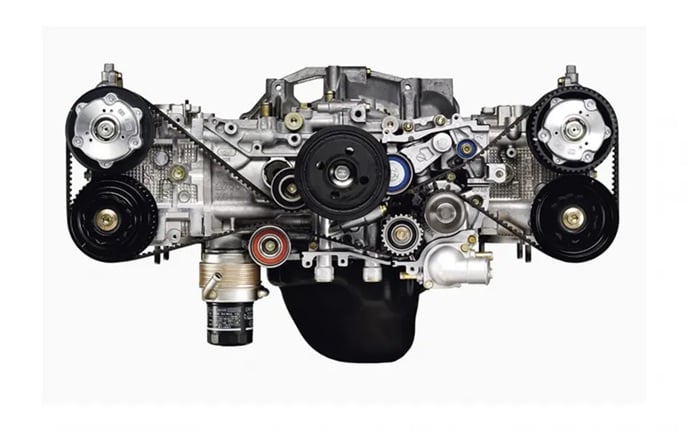
1/ Introduction
An engine is a machine that converts energy from various sources - such as chemical fuel, electricity, steam, or gas - into mechanical power or motion. Engines form the backbone of modern transportation, industrial machinery, power generation, and countless everyday devices.
2/ Classification of Engines
Engines can be broadly classified by their energy conversion method and configuration:
- Internal Combustion Engines (ICE): Burn fuel-air mixtures inside cylinders (e.g., gasoline, diesel)
- External Combustion Engines: Burn fuel outside the working fluid chamber (e.g., steam turbines)
- Electric Motors: Convert electrical energy directly to mechanical rotation
- Hybrid Systems: Combine ICE and electric motors for optimized efficiency and reduced emissions
3/ Internal Combustion Engines
3.1/ Principle of Operation
Most ICEs operate on established thermodynamic cycles:
- Otto Cycle (four-stroke gasoline engines): Intake, compression, expansion (power), exhaust
- Diesel Cycle (four-stroke diesel engines): Higher compression ratios; fuel injected at end of compression
- Two-Stroke Cycle: Completes a power cycle in two piston strokes, enabling higher power density but with greater emissions and lower efficiency compared to four-stroke designs.
3.2/ Major Components
Key elements that enable combustion, motion conversion, and control include:
- Cylinder block and head: Form combustion chamber
- Piston and rings: Seal chamber and transfer pressure forces
- Connecting rod and crankshaft: Convert reciprocating motion into rotation
- Valvetrain (camshaft, valves): Control intake and exhaust timing
- Fuel system (injector or carburetor) and ignition (spark plug)
- Lubrication and cooling circuits: Manage friction and thermal loads
3.3/ Performance Metrics
Engine performance is evaluated by parameters such as:
- Power output (kW or HP) and torque (Nm)
- Brake Specific Fuel Consumption (BSFC): Fuel mass flow per unit power
- Thermal efficiency: Ratio of mechanical work to fuel energy input
- Emissions profile (CO₂, NOₓ, particulates) and noise characteristics
4/ Electric Motors
4.1/ Operating Principle
Electric motors rely on electromagnetic interactions: current‐carrying conductors in a magnetic field generate torque on the rotor, producing continuous rotation.
4.2/ Types of Motors
- DC Motors: Simple speed control; require brushes and commutators
- AC Induction Motors: Robust, brushless design; rotor currents induced by stator field
- Synchronous Motors: Rotor speed locked to stator field frequency; can use permanent magnets or wound rotors
- Specialized Motors: Stepper and servo motors for precise position and speed control in robotics and CNC systems
4.3/ Key Components
- Stator: Laminated iron core with winding for magnetic field
- Rotor: Cage or wound element that interacts with stator field
- Bearings and housing: Support shaft alignment and heat dissipation
- Drive electronics: Inverters or controllers for speed and torque management
4.4/ Efficiency and Control
Electric motors achieve efficiencies up to 95% under optimal conditions. Advanced drives implement pulse‐width modulation and vector control to maintain high torque at low speeds and regenerative braking.
5/ Turbomachinery: Gas and Steam Turbines
Gas and steam turbines use high‐pressure fluid expansion through multiple rotating stages:
- Gas Turbines: Combustion generates hot gases that drive turbine blades; common in aviation and power plants
- Steam Turbines: High-pressure steam expanded across stages; widely used in electricity generation and industrial processes
Combined‐cycle plants pair gas and steam turbines to reach overall thermal efficiencies of 50 - 60%.
6/ Key Evaluation Criteria
When selecting or designing an engine, engineers consider:
- Rated power and torque curves versus speed
- Efficiency maps and peak thermal performance
- Durability under cyclic loads and thermal stresses
- Environmental impact and compliance with emissions regulations
- Size, weight, and cost constraints for the intended application
7/ Applications
- Automotive and commercial vehicles (ICE, hybrid, electric)
- Aerospace (turbofan engines, turboshafts)
- Marine propulsion (diesel, gas turbines, electric drives)
- Industrial machinery (pumps, compressors, conveyors)
- Power generation and distributed energy resources
8/ Emerging Trends
- Electrification and hybridization of mobility
- Higher‐efficiency motor ratings (IE4, IE5) and advanced inverter technologies
- Integration of sensors and AI for predictive maintenance
- Alternative fuels: hydrogen combustion, biofuels, synthetic e‐fuels
- Additive manufacturing for optimized component geometries
QTE Technologies is currently distributing motors of many well-known brands in the world.
We are proud to be a global MRO provider, serving customers in more than 180 countries and always go to great lengths to ensure our customers have a complete and satisfying experience. We established in 2010 supply more than 1 million products for every industry and science and technology. Also, you can contact us at any time through 24×7 chat support, phone, WhatsApp, or email. Discover what our valued customers have to say about our services on our dedicated review page.
Article author: Editorial board of QTE Technologies (with a strong background in both engineering and creativity - accumulating more than 15 years of experience).




